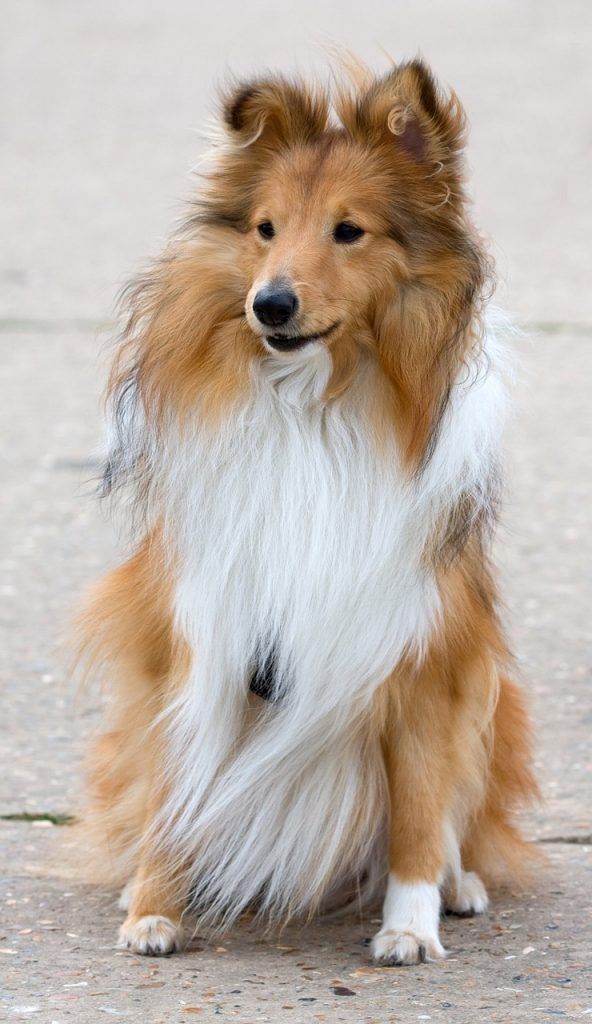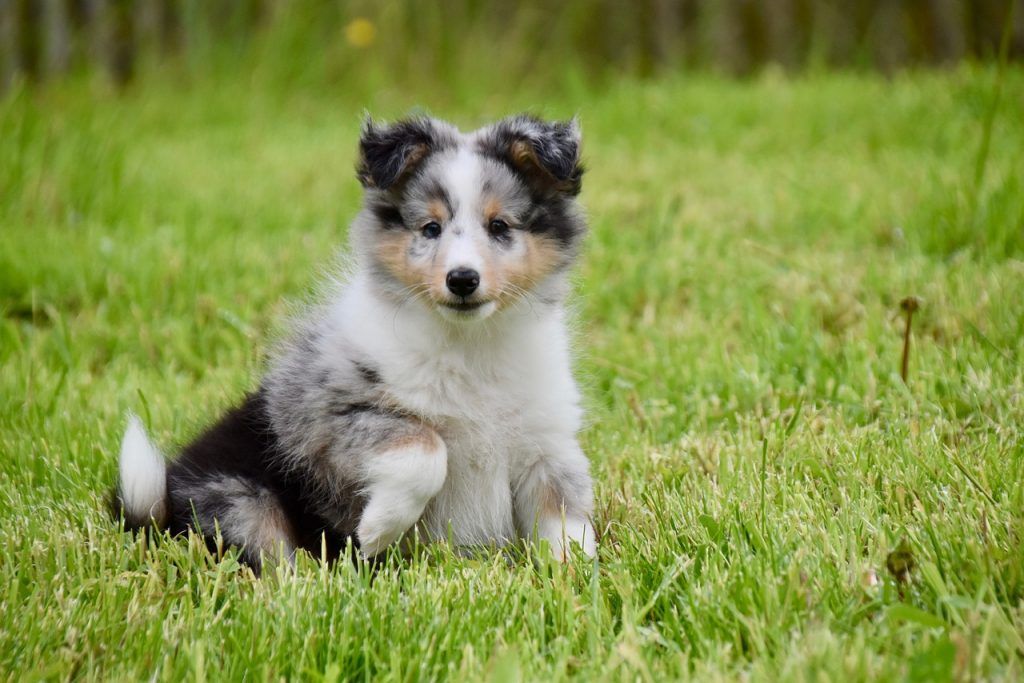The Shetland Sheepdog, also known as the Sheltie, is a small, active, and agile herding dog that originated in the rugged Shetland Islands of Scotland. The breed has a strong family resemblance to its bigger cousin, the Collie, but with some distinctive features and characteristics. Read on, and let’s explore this intelligent and loyal breed’s history, appearance, personality, health, and care.
History of the Shetland Sheepdog Breed
The Shetland Sheepdog was developed in the 18th and 19th centuries by farmers and crofters in the Shetland Islands, a remote archipelago near the Arctic Circle. The islands are known for their harsh climate and sparse vegetation, which led to the development of small and hardy livestock, such as Shetland ponies, sheep, and, you guessed it..dogs.
Farmers needed a dog that could herd and guard these animals and be a companion and watchdog. They crossed local spitz-type dogs with Collies brought from mainland Scotland and later with other breeds such as King Charles Spaniel, Pomeranian, and Border Collie. The result was a miniature Collie-like dog that was well adapted to the island life.
The breed’s original name was Shetland Collie, but this caused controversy among Rough Collie breeders who objected to using the term Collie for a different breed. In 1909, the breed was officially renamed Shetland Sheepdog by the Kennel Club of England. The American Kennel Club (AKC) registered the first Sheltie in 1911.
The breed gained popularity in the 20th century as a show dog and a pet. Today, the Sheltie ranks 27th among 199 breeds in the AKC breed popularity ranking.
Breed Overview
| Dog Breed | Shetland Sheepdog |
|---|---|
| Nicknames | Sheltie, Toonie Dog |
| Coat | Double coat, long and harsh outer coat, dense and soft undercoat |
| Coat Colors | Black, blue merle, sable |
| Coat Patterns | White markings on chest, neck, legs, tail tip, and sometimes face; tan markings on face, chest, legs, and tail (optional) |
| Weight | 15 to 25 pounds |
| Height | 13 to 16 inches at the shoulder |
| Lifespan | 12 to 14 years |
| Origin | Shetland Islands, Scotland |
| Breed Ranking | 27th among 199 breeds in the AKC breed popularity ranking |
Physical Appearance
The Shetland Sheepdog is a small but sturdy dog that stands between 13 and 16 inches at the shoulder and weighs between 15 and 25 pounds. The breed has a long, wedge-shaped head, tapered muzzle, and black nose. The eyes are almond-shaped and dark, except in blue merles, where they can be blue or partially blue. The ears are small and three-quarters erect, with the tips folding forward.
Their double coat consists of a dense undercoat and a long, harsh outer coat that sheds dirt and water. It comes in three main colors: black, blue merle (a mottled gray-blue color), and sable (a brown color ranging from light gold to dark mahogany). There are a few other less common colors, which we’ll get into in the next section.
All colors have white markings on the chest, neck, legs, tail tip, and sometimes on the face. Some dogs may also have tan markings on the face, chest, legs, and tail.
The coat requires regular brushing to prevent mats and tangles, especially during shedding seasons. The breed also needs occasional trimming around the ears, feet, and hocks.
The Sheltie is not a hypoallergenic breed and may not be suitable for people with allergies.
The Sheltie has a graceful and smooth gait that reflects its agility and speed.
The tail is long and carried low or slightly curved when relaxed, but never over the back.

The Genetics of the Shetland Sheepdog Colors
Shetland Sheepdog coloration is determined by the interaction of several genes that affect the production and distribution of two pigments: eumelanin (black) and phaeomelanin (red). The main genes that influence the Sheltie colors are:
- The Agouti gene: This gene controls the pattern of black and red pigments on the coat. There are three variants of this gene that are present in the Sheltie: sable (ay), tricolor (at), and bicolor (a). Sable is dominant over tricolor and bicolor, while tricolor is dominant over bicolor. A sable Sheltie has red fur with black tips, a tricolor Sheltie has black fur with tan markings on the face, chest, legs, and under the tail, and a bicolor Sheltie has black fur without tan markings.
- The Merle gene: This gene dilutes the base color, usually in a spotty Merle pattern. This gene has two variants: merle (M) and non-merle (m). Merle is dominant over non-merle, but when two merles are bred together, they may produce double merles (MM), which have large areas of white fur and may have health problems such as deafness or blindness. A blue merle Sheltie has a diluted black base color with black spots, while a sable merle Sheltie has a diluted red base color with red spots.
- The Spotting gene: This gene produces patches of white on the coat, as in the typical pattern of a white bib, neck, underbelly, legs, and tail tip. Several variants of this gene affect the amount and location of white markings. Some Shelties may also have a piebald pattern, also known as white factoring, which produces large areas of white on the body and head.
The combination of these genes results in the six main Sheltie colors: pure sable, mahogany sable, tri-color, blue merle, bi black, and bi blue. However, each color may have variations due to other factors such as shading, ticking (small spots of color on white areas), or modifiers (genes that alter the expression of other genes).
Personality & Temperament
The Shetland Sheepdog is an extremely intelligent, quick, and obedient dog that excels in many activities such as herding, obedience, agility, rally, tracking, therapy work, and more. They are often very sensitive and affectionate with their family members, following them around everywhere they go. Shelties are eager to please and respond well to positive reinforcement training.
Typically, this breed is very alert and protective of its home and family. They tend to bark a lot to announce visitors or anything unusual. This can make for good watchdogs but also a potential nuisance for neighbors. Shelties benefit from early socialization to become comfortable with different people, animals, and situations. They are often reserved or timid with strangers but not usually aggressive.
The breed has high energy levels and needs a lot of exercise and mental stimulation. They enjoy playing with their family members, especially children who can match their energy and enthusiasm. They also need challenging games and puzzles to keep their minds sharp and prevent boredom. Without enough physical and mental activity, a Sheltie may find less appropriate ways to entertain itself, such as chasing squirrels, birds, or cars.

Health Issues in Shetland Sheepdogs
The Shetland Sheepdog is typically a healthy and long-lived breed, with an average lifespan of 12 to 14 years. However, like any living creature, health issues may arise. Some of them may even have an underlying genetic cause, while environmental factors or lifestyle choices may influence others.
Concerned breeders of Shetland Sheepdogs are striving to breed healthy Shelties and decrease the incidence of heritable diseases in the breed. They perform health tests on their breeding stock and register the results with the Canine Health Information Center (CHIC), a database that collects health information on various breeds. The minimum health tests recommended by the American Shetland Sheepdog Association (ASSA) for Shelties are:
- Hip evaluation for hip dysplasia
- Eye examination by a board-certified veterinary ophthalmologist
- Thyroid evaluation for thyroid disease
- Von Willebrand’s disease (VWD) DNA test
Other health tests that are optional but may be useful for Shelties are:
- Elbow evaluation for elbow dysplasia
- Cardiac evaluation for heart diseases such as patent ductus arteriosus (PDA)
- Dentition evaluation for dental problems such as missing teeth, malocclusion, and periodontal disease.
- Dermatomyositis (DMS) DNA test for DMS
Some of the health problems that are not common but can affect Shelties are:
- Obesity
- Epilepsy
- Gallbladder mucoceles
- Renal disease
Owners of Shetland Sheepdogs should be aware of these health issues and consult their veterinarian if they notice any signs or symptoms. Early diagnosis and treatment can improve their Shelties’ quality and length of life.
Caring for a Shetland Sheepdog
The Shetland Sheepdog is a high-energy breed that needs lots of exercise and mental stimulation. They enjoy playing with their family members and participating in various activities. Regular grooming and nail care will keep their coat and feet in good condition. They also need companionship and attention to prevent boredom and anxiety.
Exercise
The Shetland Sheepdog needs at least an hour of exercise every day. This can include walks, runs, hikes, fetch games, agility courses, or herding trials. They love to run and chase things, so they should always be kept on a leash or in a fenced area outdoors. They also tend to enjoy swimming, but make sure to dry their coats thoroughly after getting wet.
Mental stimulation
Shetland Sheepdogs are intelligent and need mental stimulation to prevent boredom and behavior problems. This is a breed that likes to learn new tricks and tasks, so owners should provide them with positive reinforcement training and interactive toys. They also like to solve puzzles and play games that challenge their minds.
Grooming
The Shetland Sheepdog has a long coat that requires regular brushing to prevent mats and tangles, especially during shedding seasons. They also need occasional trimming around the ears, feet, and hocks. Shelties are not a hypoallergenic breed and may not be suitable for people with allergies.

Where to Buy a Shetland Sheepdog
If you are interested in buying a Shetland Sheepdog, do your research and find a reputable breeder who can provide you with health certificates and temperament tests for their dogs.
You can find a list of breeders who are American Shetland Sheepdog Association (ASSA) members on their website. You can also contact your local Sheltie club or rescue group for referrals or adoption options.
Expect to pay between $800 and $1500 for a Sheltie puppy from a reputable breeder. The price may vary depending on the puppy’s location, pedigree, and quality. Show-quality puppies, for example, will be quite a bit more costly.
Conclusion
The Shetland Sheepdog is a wonderful breed that has many qualities to offer to its owners. The breed is small but sturdy, beautiful but easy to groom, intelligent but easy to train, affectionate but alert, playful but obedient. They are versatile and adaptable, able to perform well in various activities and environments.
If you are looking for an energetic, intelligent, playful, loyal, and loving dog, the Shetland Sheepdog may be the perfect choice for you. However, if you are looking for a calm, quiet, independent, or low-maintenance dog, the Shetland Sheepdog may not be the best fit for you.
More Dog Breeds
If you’re interested in learning about similar dog breeds, check out:
Or browse our entire dog breed library!
FAQ
Do Shetland Sheepdogs shed a lot?
Yes, Shetland Sheepdogs have long thick coats that shed heavily twice a year, usually in spring and fall, and moderately throughout the year.
Are Shetland Sheepdogs good for first time owners?
Shetland Sheepdogs can be good for first time owners who are willing to provide them with enough exercise, mental stimulation, training, and socialization. They are very intelligent and eager to please but also need guidance and positive reinforcement.
Are Shetland Sheepdogs good with cats?
Shetland Sheepdogs can get along well with cats if they are raised with them from puppyhood or properly introduced to them. However, they may have a strong herding instinct that can make them chase or nip at cats or other small animals.
























